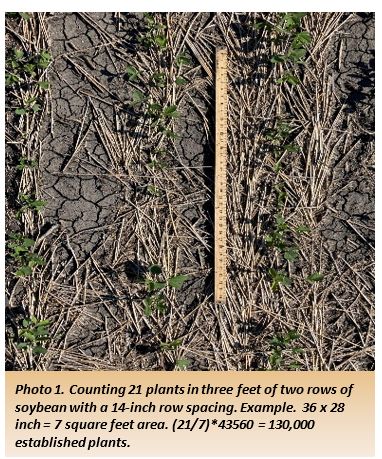Soybean Plant Population (06/17/21)
Counting soybean plants in the unifoliate growth stage or early vegetative stages with true leaves developing is a good method to evaluate the crop stand. This year has been very challenging, established plant stands are very variable due to drought conditions, and a late May frost in some fields.
Based on various hail loss studies and other plant population research, a low stand for soybean in North Dakota is around 75,000 plants per acre, which is approximately 50% of the recommended stand. If you use the “hula-hoop” method to estimate the number of plants in solid seeded fields, you would need a minimum of 1.7 plants per square foot for this 75,000 established plant population.
The hula-hoop method for solid seeded soybean stand counts uses a perfect circular hoop with a known diameter. The hoop should be tossed randomly at five or more locations in the field and plants should be counted within the hoop. The area of a hoop can be calculated by the formula: Area = πr2, where ‘r’ is the radius (or half the diameter of the hoop) and ‘π’ (pi) is approximately 3.14. As an example for a hoop with a 24 inch diameter (12 inch radius), the area is 3.14 x 122 = 452 square inches. Divide 452 square inches by 144 square inches (a square foot) to equal 3.14 square feet. If the average number of plants in this hoop is six, the population estimate can be calculated to be 6 (average plants in hoop) / 3.14 (area of the hoop in square feet) x 43,560 (square feet per acre) = 83,236 plants per acre.
With 30, 15, or 7 inch row spacing you need at least on average 4.3, 2.2, and 1 plants per foot of row, respectively, to equal 75,000 plants per acre. It is important to count several feet per row in various locations per field and average the numbers to estimate the stand (Photo 1).
With a 50% reduced stand, yield reduction will be somewhere between 10-20% of the potential yield of a timely planted soybean field with 150,000 established plants, if the growing conditions during the rest of the season will be favorable. Of course, if drought conditions continue then the yield potential will be lower. Soybean stands usually are not uniform throughout the field. There will be areas with higher or lower plant counts. With uneven emergence and gaps between plants, yields may be lower compared with an evenly distributed low stand of 75,000 plants per acre. Soybeans have the ability to compensate for low number of plants per acre by additional branching, producing more pods per plant, filling more seeds per pod, and increased seed size.

Extension Agronomist Broadleaf Crops


